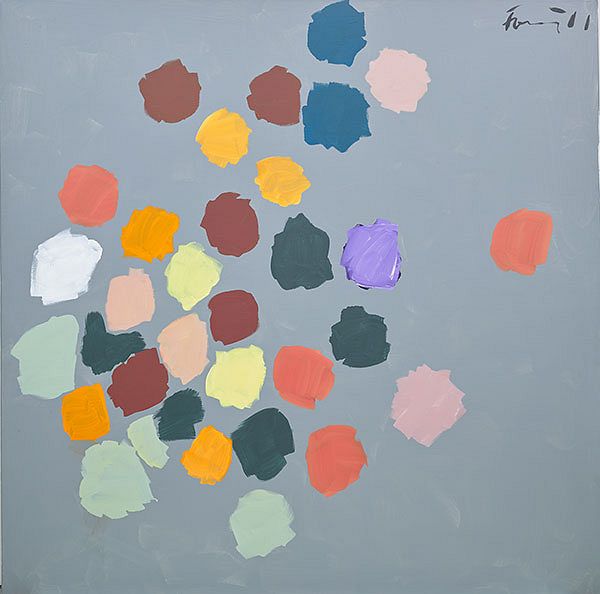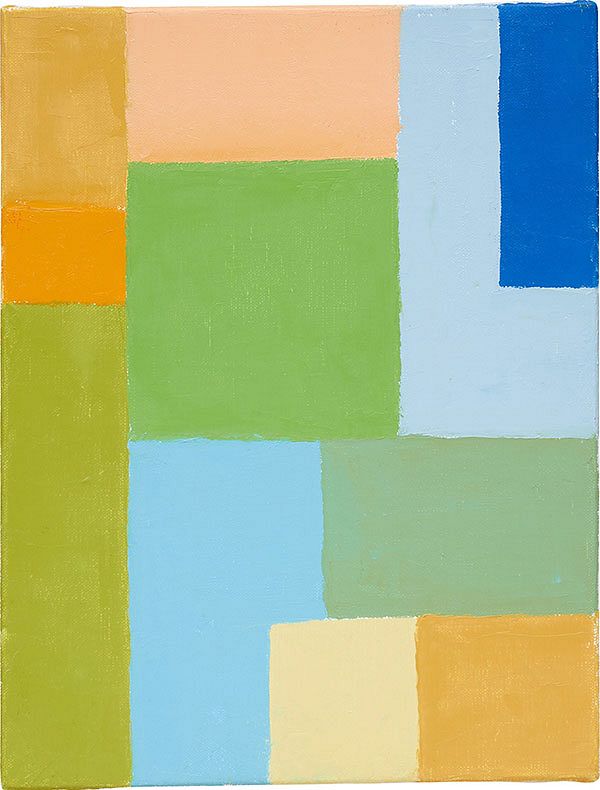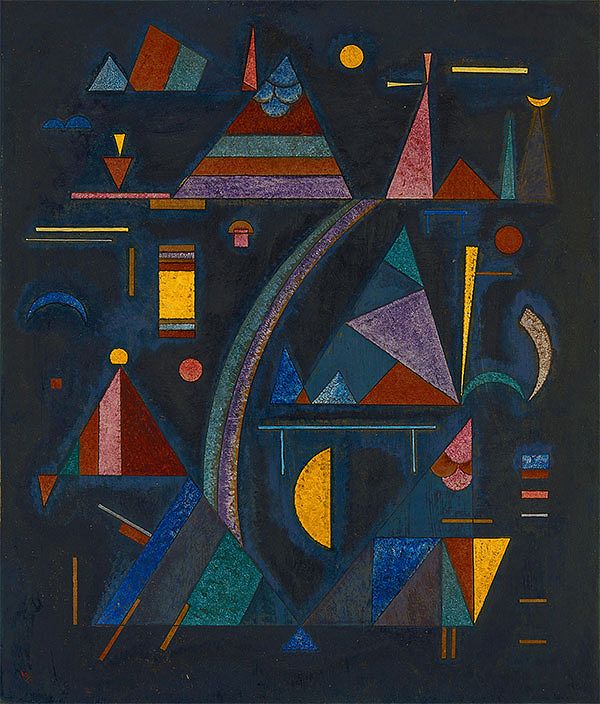Gerhard Richter, Abstraktes Bild (P1), 2014. 20th Century & Contemporary Art.
Written by Arian Murati
It is one of life’s simple, adorned joys to speak to my father about art, in that the man could not possibly care less about it. He is a butcher by trade – when I half-jokingly show him Francis Bacon paintings he might resonate with, he says he sees sides of beef every day; why would he pay to look at one? He has never been inside a museum on his own volition, but as is the case with many immigrant parents, he drove his kids uptown to the Met on occasion in the 90s with a nebulous instinct that exposure to fine culture would, though a combination of osmosis and American dreaming, help us do well at some point in life, and doubly so because it was free. Likewise now with my father-in-law, whose interest in art begins and ends at the decorative shipwreck painting on his living room wall at the Jersey shore. On just about all subjects – politics, sports, television, scrap metal – these two men of a certain age will never agree, however once a year they meet at my house for the holidays and see eye to eye perfectly on one thing: the cheap Kandinsky print I keep on my bookshelf is not real art. Real art, they combine to insist, looks like what it’s supposed to look like. A bridge is a bridge, just like a flower is a flower and a horse is a horse. Salt of the earth lads. Unconditional love for our old boys.

Gunther Förg, Untitled, 2001. 20th Century & Contemporary Art.
These encounters are merely illustrative, ultimately harmless – they are after all more relative to the spectacle of abstract art than the concept of it. Most people don't hold a conviction beyond the banter. The image of someone who otherwise wouldn’t care about art suddenly becoming a prickly critic is in any case easy to conjure. They can skew younger, like a wry partner with a data-driven mindset who misses the painting of the forest for the unit value of the trees, but regardless of the person, the experiences inspire an interesting thought: In the very near future, when the biometric gallery graduates from novelty to ubiquity, when the wearables on our faces and metaverse devices on our persons are fully able to track and interpret our engagement with art beyond crude measurements of time spent looking at a piece or how we move through the space, the bleeding edge of tech and culture might still fail to reckon with an even cruder response from a visitor upon seeing a Rothko for the first time: Hell, I could paint that!
The reason for this does not owe a thought to notions about erudition or highbrow pretentiousness; in fact, this is a distraction; rather it stems from the wholesale flattening of culture itself, that through its contrivances can provide nothing but a zero-sum understanding of abstract art, marking a fundamental dissonance and conflation of abstract forms in contemporary life that only abstraction, properly understood, can resolve in good faith with a simplicity that can be grasped as well and as immediately as any figurative realism. For this we turn to the philosopher Byung-Chul Han, who writes in Good Entertainment that culture is “based on deviation, on a luxation of the natural, that the flower in the field, beautiful and splendid as it may be, is not yet culture. […] To the contrary, it is the abstraction of scene from flower, the abstraction from nature of something proper to oneself, that counts as an achievement of culture.” The life of the flower is extended through abstraction – “Its sumptuous brilliance is the antithesis of death. It postpones death, which is an event of nature.” Art requires luxation for its very purpose, and this becomes possible through abstraction. Our ability to render the distinction between this life-affirming form of abstraction and its inverse, everyday abstraction, reveals the difficulty in developing an acumen, or a “mental capacity to decipher fine similarities or dissimilarities between things” that today has a codified manner of guiding our expectations of the flower to look like a flower and nothing different, because to be obscure is to be unacceptable to a totalizing flatness.

Jo Baer, Untitled, 1964-68. 20th Century & Contemporary Art.
We passively accept abstraction in its everyday form, whether we like it or not. This is the hegemonic form of abstraction, that of things like Big Data and its tendency towards obliteration of the mass into buckets of knowable, marketable components. The rise of Abstract Expressionism in the United States in the 1950s and 60s served convergent purposes for artists seeking to liberate form from content, as well as currents we tend to forget about, namely the three-letter agencies seeking to liberate abstraction from competing ideological frameworks in red-tinted parts of the world to tether the concept to appreciable, star-spangled precepts of individualism and enterprise. We can extend a good courtesy to the artists of the time and proceed under the supposition that their participation was unwitting, and their works appropriated for those means, indeed hammering down the first mile marker in abstraction’s shift from vanguard movement to today’s end user agreements. In other words, where unwittingness was once a requisite, consent now forms the foundational element of everyday abstraction.
And yet, this form of abstraction is both pervasive and terminal to the extent that its omnipresence is irrepressible, thus extending itself into our understanding of art in much the same way – by making itself the sole framework for the concept. Rather than understanding abstraction as a flourish of life or an amplification of joy, it becomes the means through which confrontation with the unknowable becomes a reflexive dismissal of anything that cannot be calibrated, packaged, and marketed back to us by systems that can’t find a productive use for it. This quantification, be it though likes or shares or posts, makes everything imaginable a consumer good, and art is not spared. Han writes in The Palliative Society: “This leads to a mingling of the artistic and consumer spheres which, in turn, means that the arts come to draw upon the aesthetics of consumption. Art becomes likeable.”

Mimmo Rotella, Il Jazz, 1956. 20th Century & Contemporary Art.
This has a secondary effect of attenuating our cultural tastes, and further resulting in a conditioned perception of abstract art as being counterproductive or pure spectacle, meaning we get hung up on its purpose instead of its capacity; we look too much for reason and not enough for fascination. As the undergrads say: the social platforms are free because we are the product. Art that requires little to no engagement operates with a similar logic. Imagine that your fitness tracker will soon enough (if it doesn't already) combine with your doorbell camera to track your heart rate spiking on Tuesday afternoons, when a certain car is visible in your driveway and your husband’s watch indicates he’s at work and suddenly sees divorce attorney ads in his feed. What is this but vulgar and complete abstraction for tangible ends?
Abstract art repels this encroachment by virtue of its groundlessness, its inaccessibility. Its ends cannot be evaluated the way everyday abstraction arrives at material results. Engagement with abstraction requires this fundamental understanding. Otherwise, it is subsumed by the machinery of the everyday. “Art that aims to serve human well-being is, accordingly, a contradiction,” Han notes. “Art must be able to alienate, irritate, disturb, and, yes, even to be painful. It dwells somewhere else. It is at home in what is foreign. It is just this foreignness that accounts for the aura of the artwork.” This is an element that exists in all worthwhile art, abstract or otherwise. When we look at The Dog from Francisco Goya’s Black Paintings, we know we are looking at a generally realistic portrayal of the animal, but the fear, tension, and dread we become overwhelmed with come from the depths of human abstraction, the “necessary form that finds fulfillment in neither practicality nor instrumental reason” and isn’t plainly understandable. When we take in Etel Adnan or Joan Mitchell paintings – quite a few of which are appropriately untitled – we at once form the connective tissue of meaning with image and yet still, almost primordially, allow for a certain unknowable distance or space, implying that something within them, and somewhere out there, something we haven’t yet figured out still exists and creates a tension that can be immediately dismissed, as we are trained to do, or welcomed, as we must train ourselves to do.

Etel Adnan, Untitled, 2015. 20th Century & Contemporary Art.
On these terms the epiphany of art can feel more like a form of apophony, or the imagined connection between unrelated concepts, only now mediated by a third party which seeks to destroy both. Instrumental reason insists that joy through art cannot simply spring forth and be without source – it must be the logical conclusion of intersecting, observable paths that deliver the viewer to a given end point and can be replicated for another viewer. This isn’t to say that abstraction requires a sublime dimension – it can be as base or as eminent as the viewer interprets; it is rather the insistence on representational transcendence-through-understanding that today has more to do with algorithmic planning than self-discovery. There is beauty in all forms of art, but it is only abstraction that deviates from the surveyable everyday and provides life today with its ornamental brilliance. The elusive unknowable is something beyond function and ends following means. It is something inherent to abstract art’s ability to always remain a step beyond the operational logic of its moment in time, from its earliest prehistory through the present, and the artists who create it intrinsically understand that liberating sentiment. It will continue to slip through the cracks so long as it isn’t imposed upon with familiarity. The foreignness of abstract art prevents it from being appropriated to do our thinking for us, and for that reason, ought to be given pride of place in our appreciation of the form. A bridge is a rose, a rose is a horse, and the Kandinsky print on the bookshelf is staying put. Happy holidays.

Wassily Kandinsky, Fliessend, 1931. 20th Century & Contemporary Art.
Discover More from 20th Century & Contemporary Art >
Recommended Reading
